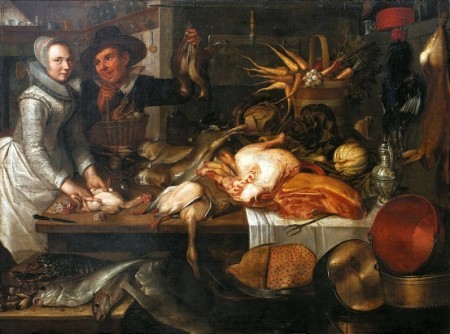Sarah Albee's Blog, page 8
October 29, 2015
Retro Recipes
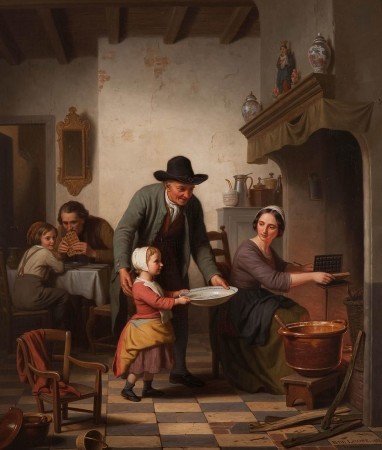 Need some new ideas for dinner? I am here to share recipes from an eighteenth century book that was popular in colonial America. Published in 1737 by William Kendrick, it’s called The Whole Duty of Woman, or, An Infallible Guide to the Fair Sex. (Could there be a more off-putting title?) I suspect that the recipes in this volume may have been what we might today call “aspirational,” like the ones you see in modern-day cookbooks that have been written by chefs who have platoons of sous chefs at their disposal. For instance, many of these require multiple pots and pans, and the vast majority of colonial Americans were lucky if they had one pot or pan. Another thing that jumps out: early Americans weren’t big on vegetables. Have a look. (With apologies to my vegetarian friends.)
Need some new ideas for dinner? I am here to share recipes from an eighteenth century book that was popular in colonial America. Published in 1737 by William Kendrick, it’s called The Whole Duty of Woman, or, An Infallible Guide to the Fair Sex. (Could there be a more off-putting title?) I suspect that the recipes in this volume may have been what we might today call “aspirational,” like the ones you see in modern-day cookbooks that have been written by chefs who have platoons of sous chefs at their disposal. For instance, many of these require multiple pots and pans, and the vast majority of colonial Americans were lucky if they had one pot or pan. Another thing that jumps out: early Americans weren’t big on vegetables. Have a look. (With apologies to my vegetarian friends.)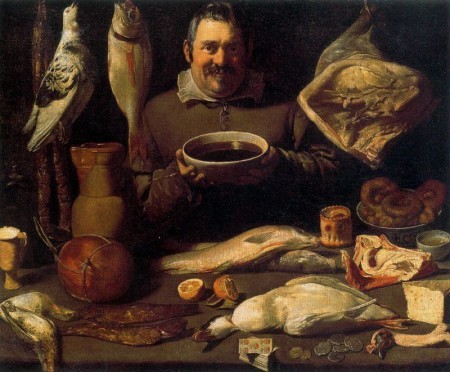
Black Puddings
Put in a Stew-pan some Hog’s Blood, a little Milk, and a Ladle full of fat Broth; then cut a sufficient Quantity of thin Slices of Hog’s Fat, with some Parsley, Cives, and Sweet Herbs cut small; put the whole into your Stew-pan, season it with Salt, Pepper, Spice, and Onions done in hot Ashes, and cut small, mix this with your Blood, then make your Puddings as big as you please. Your Guts being well cleansed, scraped and scalded, blanch them in hot Water, and prick them with a Pin, and if you see the Fat come out, they are blanched enough, then take them out of the Water, broil them, and serve them up hot.
Cut it in Quarters and lay it in your Stew-pan; To one Calf’s Foot and the Pig’s Feet, put in a Pint of Rhenish Wine, the Juice of four Lemons, and one Quart of Water; season with Nutmeg and Salt; stove it gently two Hours, let it stand ‘till cold, and send it up in its Jelly.
To Souce a Pig
Cut off the Head of a fair large Pig, then slit him through the Midst [ed note: disconcerting pronoun use], then take out his Bones, then lay him in warm Water one Night, then collar him up like Brawn, then boil him tender in fair Water, and when he is boiled, put him in an Earthen Pot or Pan, in Water and Salt, for that will make him white, and season the Flesh for you must not put Salt in the boiling, for that will make it black [ed. note: um, what?], then take a Quart of the same Broth, and a Quart of White Wine, boil them together to make some Souce for it, put into it two or three Bay Leaves, when it is cold uncloath the Pig, and put it into the same Souce, and it will continue a Quarter of a Year [ed note: a Quarter of a Year. That’s what it says.]. It is a necessary Dish in any Gentleman’s House; when you serve it in, serve it with green Fennel, as you do Sturgeon with Vinegar in Saucers.
Ducks Tongues
Get as many Ducks, or Geese Tongues as you can; fifty Tongues will fill up a small Dish. Blanch them, put them in a Stew-pan over some Slices of Bacon, with Onions cut in Slices, and some Sprigs of Sweet Basil; season it with Salt, Pepper, and some Slices of Bacon, moisten it with a Spoonful of Broth, let it stew together. The Tongues being done, drain them, and put them, in some Essence of Ham, or an Italian Sauce, put them, for a Minute, over the Fire to take a Relish. Being ready to serve, let your Tongues be relishing, add the Juice of a Lemon; serve them up hot for a dainty Dish. At another Time [because your family will be clamoring to have you make this again], you may garnish them with Mushrooms, Truffles, Cocks Kidneys and Cocks Combs.
A Calf’s Head Pie
Boil your Calf’s Head, ‘till you can take out all the bones, slice into thin Slices and lay it in the Pie, with the Ingredients for savoury Pies. [ed note: It doesn’t say what the cook is supposed to do with the brain. I suspect it’s already been removed and put aside for another dish. One of those ever-helpful “reserve for another use.”]
And if you’re considering making a rabbit, here’s how to truss a hare “in the most fashionable Way.” I do wish the rabbit’s expression weren’t so . . . emotive.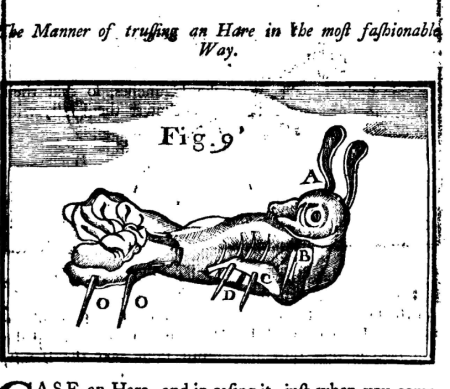
The post Retro Recipes appeared first on Sarah Albee.
October 23, 2015
Puff Piece
I’m working on two different projects at the moment, one about poison, the other about colonial America, so I’ve been reading a lot about tobacco.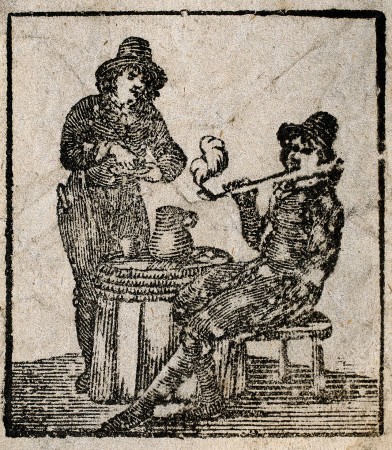 By the middle of the seventeenth century, when the Jamestown colonists figured out how to grow tobacco, pipe smoking quickly became extremely popular in England. It was smoked in long clay pipes.
By the middle of the seventeenth century, when the Jamestown colonists figured out how to grow tobacco, pipe smoking quickly became extremely popular in England. It was smoked in long clay pipes.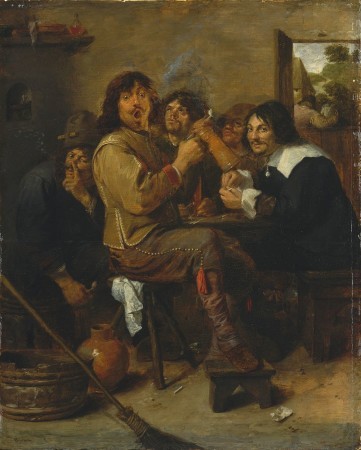 Tobacco was widely thought to be a sort of miracle drug for all sorts of ailments, from head colds to cancer. A special kind of medicinal enema forced tobacco smoke up a person’s “back end.” Here’s a “tobacco clyster,” used to resuscitate drowning victims.
Tobacco was widely thought to be a sort of miracle drug for all sorts of ailments, from head colds to cancer. A special kind of medicinal enema forced tobacco smoke up a person’s “back end.” Here’s a “tobacco clyster,” used to resuscitate drowning victims.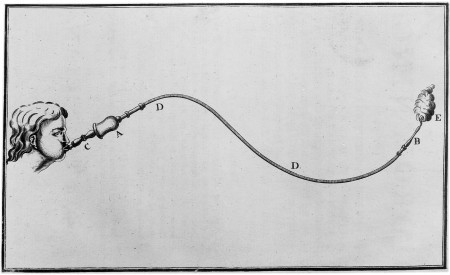 Smoking really took off during the plague of 1665. Children were sent to school with pipes. Those who didn’t know how to smoke were instructed by the teacher.
Smoking really took off during the plague of 1665. Children were sent to school with pipes. Those who didn’t know how to smoke were instructed by the teacher.
You can’t make this stuff up.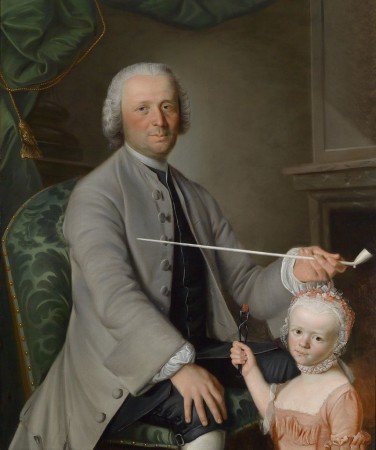 In France and Spain, snuff was more popular than smoking. If you think about it, sniffing the powdered form of tobacco would be a lot more convenient than smoking it, before matches were available. By the 1770s, London tobacco sellers sold 80 percent snuff and only 20 percent pipe tobacco.
In France and Spain, snuff was more popular than smoking. If you think about it, sniffing the powdered form of tobacco would be a lot more convenient than smoking it, before matches were available. By the 1770s, London tobacco sellers sold 80 percent snuff and only 20 percent pipe tobacco. 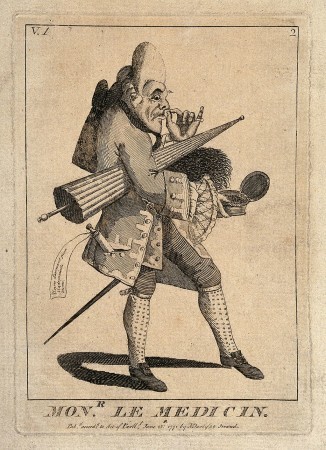 It wasn’t until the first decade of the nineteenth century that matches were invented and cigars showed up. Cigarettes became popular around the turn of the next century.
It wasn’t until the first decade of the nineteenth century that matches were invented and cigars showed up. Cigarettes became popular around the turn of the next century.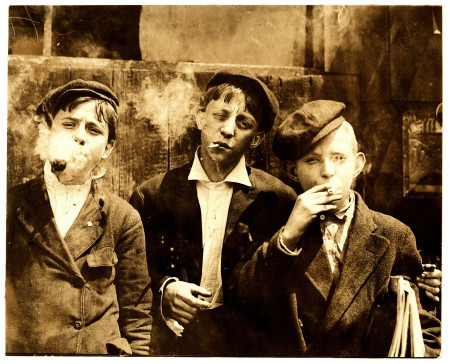
The post Puff Piece appeared first on Sarah Albee.
October 19, 2015
Whirlwind Weekend
My whirlwind of author visits and festivals continued through this past weekend. On Friday, I visited the Friends Academy in Dartmouth, Massachusetts. Janice Griffin is the librarian there, and she planned an amazing day that began in the preschool “Farmhouse” and included the best gourmet lunch for me ever, prepared from her niece’s organic garden. Here’s the display that greeted me: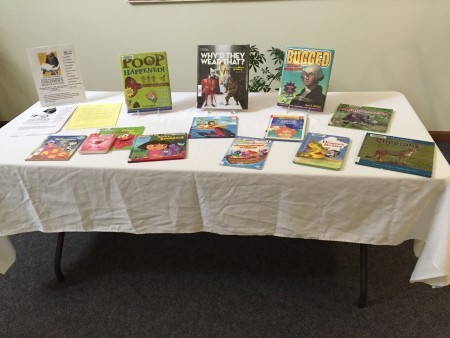
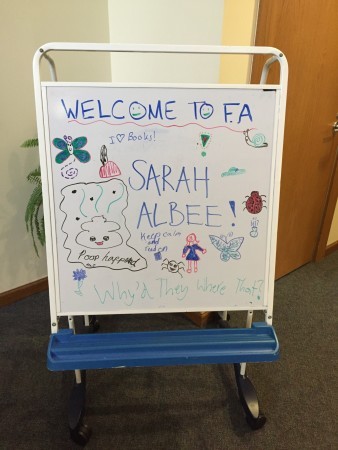 And here are signs made for me by the preschoolers (including a portrait of me):
And here are signs made for me by the preschoolers (including a portrait of me):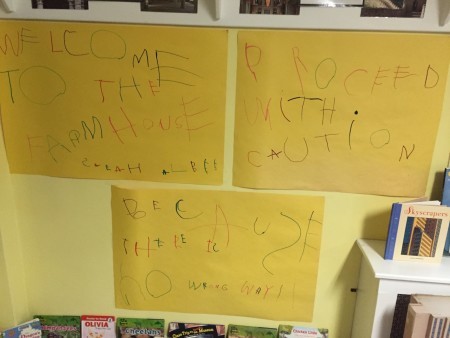
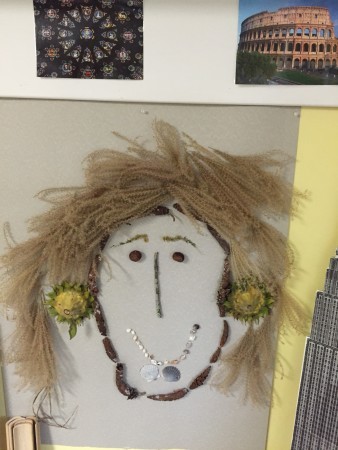 We witnessed this dramatic hailstorm:
We witnessed this dramatic hailstorm: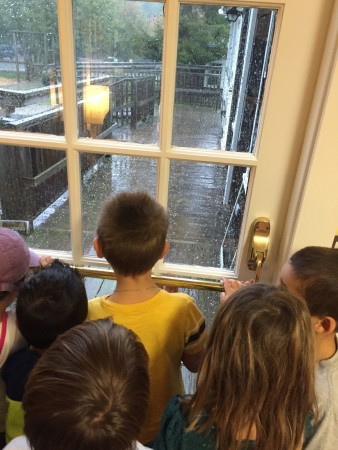 And then I spoke to three groups of kids in K – 8. They had fantastic questions, and were super-enthusiastic about volunteering to emulate yellow fever victims and to be dressed in bumrolls and ruff collars.
And then I spoke to three groups of kids in K – 8. They had fantastic questions, and were super-enthusiastic about volunteering to emulate yellow fever victims and to be dressed in bumrolls and ruff collars.
On Saturday, I participated in the Rhode Island Festival of Children’s Books with fellow authors and illustrators. Here we all are:

From back left: Scott Magoon, Aaron Becker, Chris Grabenstein, Meghan McCarthy, me, Heidi Stemple, Rita Garcia-Williams, Gordon Korman, Jane Yolen, Grace Lin, Liz Kessler
My author panel was me and Meghan McCarthy, talking with the amazing Susannah Richards about nonfiction. 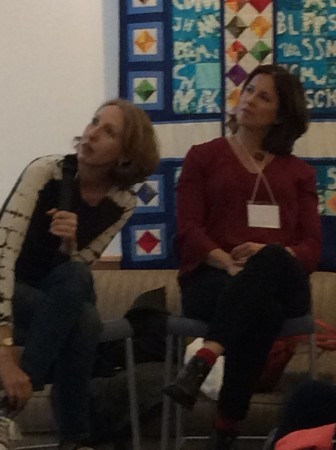
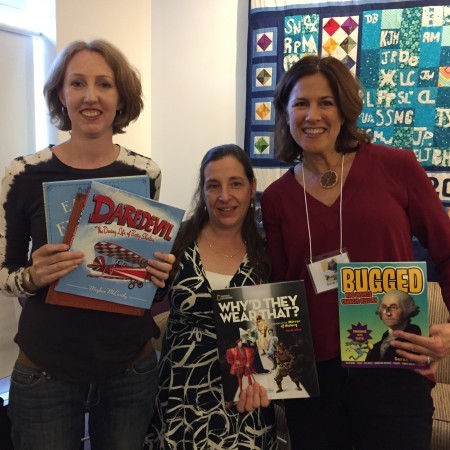 And here’s my personal sign from the signing area, which I plan to frame.
And here’s my personal sign from the signing area, which I plan to frame.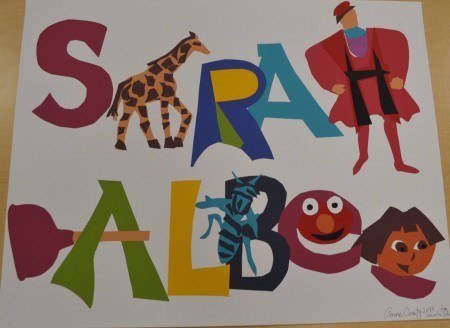
The post Whirlwind Weekend appeared first on Sarah Albee.
October 15, 2015
Visits, Real and Virtual
This past week has been full of opportunities to meet with and talk to kids, both in person and via Skype. On Monday I gave a talk in Darien, Connecticut, at the library, about my latest book, Why’d They Wear That? I wasn’t expecting many people to show up, as it was both a holiday and a beautiful day, but lots of kids and their parents came. I love the Darien Library, and the librarians I met who’d organized the event were awesome.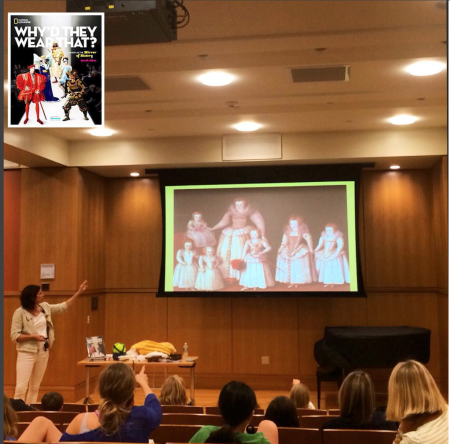 Last week was also a big Skype week (as I’m on a deadline, I clumped many skype visits into two afternoons), and I met with kids in multiple schools across the country. I spoke with kids in grades 1, 3, 5, 6, and 8, and one evening, even some teachers who are working on advanced teaching degrees. I forgot to take many pictures, so I “borrowed” most of these from teachers’ posts on Twitter. But here are some highlights:
Last week was also a big Skype week (as I’m on a deadline, I clumped many skype visits into two afternoons), and I met with kids in multiple schools across the country. I spoke with kids in grades 1, 3, 5, 6, and 8, and one evening, even some teachers who are working on advanced teaching degrees. I forgot to take many pictures, so I “borrowed” most of these from teachers’ posts on Twitter. But here are some highlights: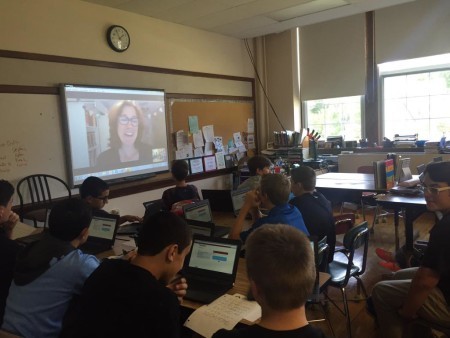
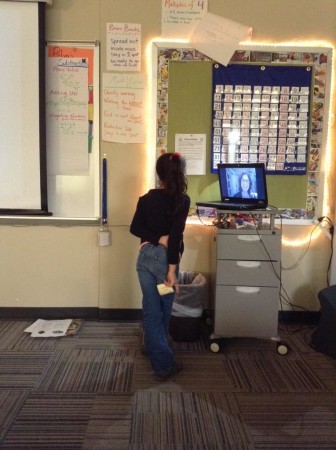
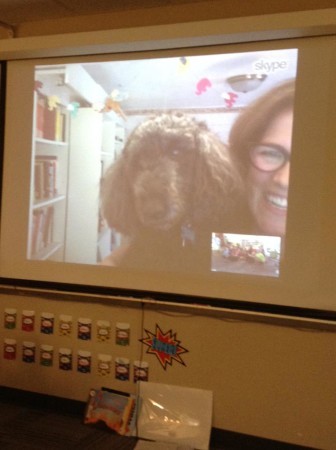
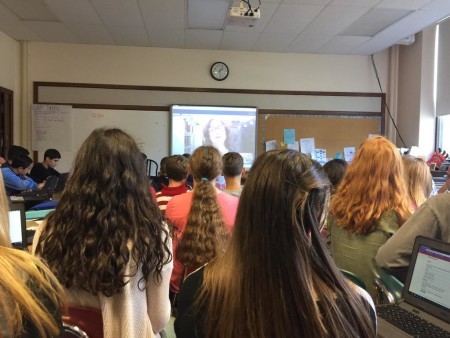
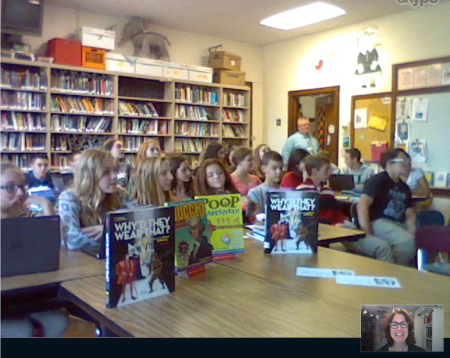
Today I’m heading to Providence, Rhode Island, where I’ll be visiting a school on Friday and then participating in the Rhode Island Festival of Children’s Books on Saturday. I hope you’ll stop by and say hello if you’re in the area!
The post Visits, Real and Virtual appeared first on Sarah Albee.
October 8, 2015
Darien (CT) Library
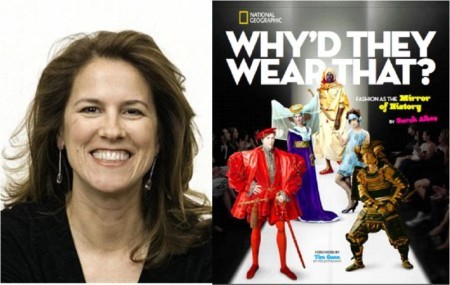 Connecticut friends–this coming Monday, October 12th, I’m going to be speaking about my book, Why’d They Wear That? at the Darien Library at 3 pm in Darien, Connecticut. Here’s the link. Please stop by if you are in the neighborhood. I love this library so much. I’ve spent many hours researching there. It has a fantastic children’s section–and there’s even a snack bar on the first floor!
Connecticut friends–this coming Monday, October 12th, I’m going to be speaking about my book, Why’d They Wear That? at the Darien Library at 3 pm in Darien, Connecticut. Here’s the link. Please stop by if you are in the neighborhood. I love this library so much. I’ve spent many hours researching there. It has a fantastic children’s section–and there’s even a snack bar on the first floor!
The post Darien (CT) Library appeared first on Sarah Albee.
October 5, 2015
Williamsburg and Jamestown

The approach to Jamestown.
I am back from a week in Colonial Williamsburg and Jamestown, Virginia, where I went to do research for a book. Conveniently, I was able to go with my history-teacher husband, because he’s on sabbatical this year. He had meetings set up with several members of the Colonial Williamsburg education department to discuss the educational resources that are available at their new, amazing multimedia library and e-learning site. It was developed by teachers for teachers. (Teachers! It is an incredible resource! Check it out! )
I’ll share just a few highlights. First, the apothecary shop, where the super-knowledgeable apothecary showed me cinchona bark (infused in brandy, it was used to treat malaria–eventually quinine was derived from it):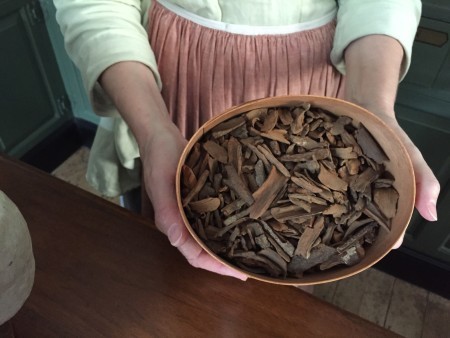 And actual blister beetles (cantharides)–when ground up into a powder, they were applied as blister poultices:
And actual blister beetles (cantharides)–when ground up into a powder, they were applied as blister poultices: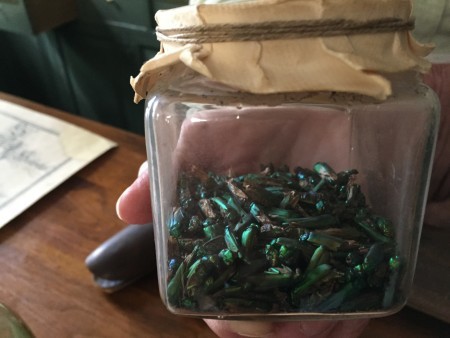 And of course I snapped a picture of this clyster (in case you missed my blog about enemas you can read that here).
And of course I snapped a picture of this clyster (in case you missed my blog about enemas you can read that here).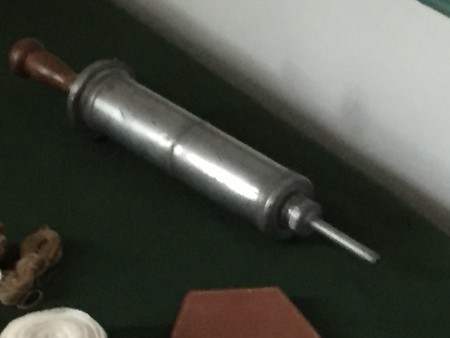 At the milliner’s, the tailor showed me actual cochineal, a type of scale insect used for red dye:
At the milliner’s, the tailor showed me actual cochineal, a type of scale insect used for red dye: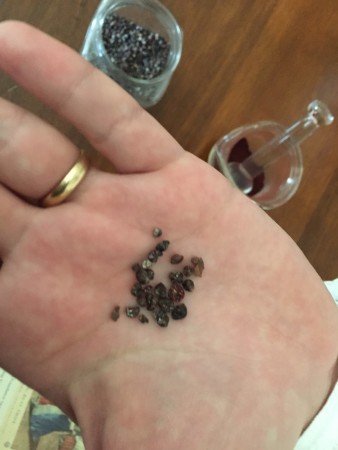
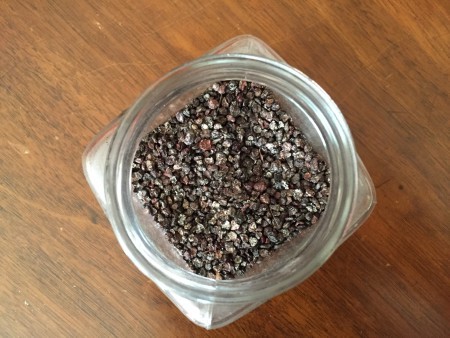 The weather was hot and humid, and the horses clopping along the street were a powerful reminder about what life in the 18th century would have smelled like. By afternoon every day, the odor of manure sort of permeated your nostrils every time you stepped outside:
The weather was hot and humid, and the horses clopping along the street were a powerful reminder about what life in the 18th century would have smelled like. By afternoon every day, the odor of manure sort of permeated your nostrils every time you stepped outside: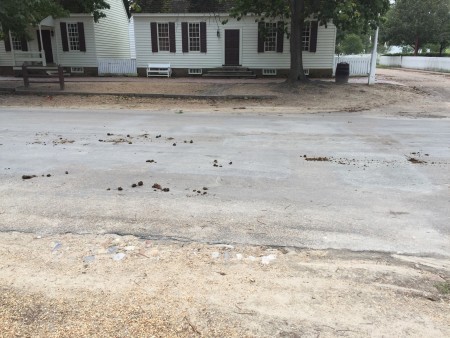 The streets get cleaned every morning, so it wasn’t overpowering, but it did drive home just how smelly actual city streets must have been.
The streets get cleaned every morning, so it wasn’t overpowering, but it did drive home just how smelly actual city streets must have been.
But this was one of my favorite moments: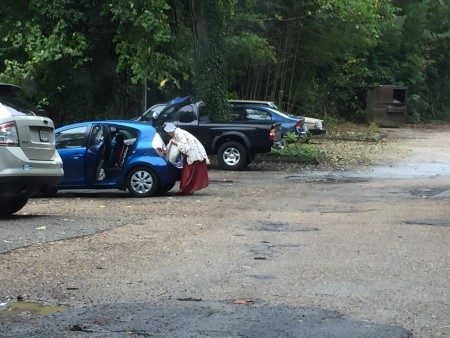
The post Williamsburg and Jamestown appeared first on Sarah Albee.
October 1, 2015
Pink and Blue
Anyone who’s ever set foot in the “girl” aisle of Toys R Us knows that modern toy manufacturers like to assign pink for girl-toys and anything but pink (usually blue or black or camouflage) for boy-toys. Nowadays everything is color-coded, even pink or blue diapers, because Heaven forbid you should scar your child by dressing him or her in the wrong color, or giving him or her the wrong toy. I’ve ranted blogged about this before. But did you know that this pink-is-for-girls, blue-is-for-boys phenomenon is relatively recent?
Pre-20th century, girls often wore blue.

 And baby boys often wore pink.
And baby boys often wore pink.

 Some poor babies had to wear stuff like this.
Some poor babies had to wear stuff like this.

According to this article in Smithsonian, toy and clothing retailers didn’t dictate pink and blue as gender signifiers until the 1940s. Prior to that, you’d see lots of images like these (note these are both boys):

A paper doll from 1920 called “Baby Bobby.” (Winterthur Museum and Library, via Smithsonian)

A 1910 boy paper doll called Percy (Winterthur Museum and Library, via Smithsonian)
And most babies, at least whose parents could afford to dress them somewhat fashionably, were made to wear long dresses and long hair until boys were “breached” at about age 6 or 7. That’s also when they got their first haircut


Special thanks to my friend, Ying Lee, for alerting me to this pink and blue historical phenomenon!
The post Pink and Blue appeared first on Sarah Albee.
September 28, 2015
Fabulous Festival
 Yesterday I signed books at the Warwick Children’s Book Festival in Warwick, New York, in a beautiful part of the Hudson Valley. It was a sparkling Fall day, with a fantastic band playing, little kids dancing, and many amazing authors and illustrators. It was really fun to see so many of my writer and illustrator pals. Thanks to the organizers for such a stunning event!
Yesterday I signed books at the Warwick Children’s Book Festival in Warwick, New York, in a beautiful part of the Hudson Valley. It was a sparkling Fall day, with a fantastic band playing, little kids dancing, and many amazing authors and illustrators. It was really fun to see so many of my writer and illustrator pals. Thanks to the organizers for such a stunning event!
Some highlights:

Ame Dyckman

Heidi Stemple

Rita Williams-Garcia, me, Wendy Mass (who had tables on either side of me–so fun!)

Joan Paquette, whose table was always so busy I had to snap this one through the crowd

Tommy Greenwald

David Lubar

Alison Formento and Kathleen Benner Duble

me and Susan Hood (she was mad I had heels on so she stood on the curb)

Rita Williams-Garcia and James E. Ransome

The post Fabulous Festival appeared first on Sarah Albee.
September 24, 2015
Warwick Children’s Book Festival
 This Saturday, September 26th, I’ll be signing books at the Warwick Children’s Book Festival, in Warwick, New York. The Festival is from 11am-4pm, rain or shine, on Railroad Avenue. Admission is free. Details here. Please stop by and say hello if you’re in the neighborhood!
This Saturday, September 26th, I’ll be signing books at the Warwick Children’s Book Festival, in Warwick, New York. The Festival is from 11am-4pm, rain or shine, on Railroad Avenue. Admission is free. Details here. Please stop by and say hello if you’re in the neighborhood!
The post Warwick Children’s Book Festival appeared first on Sarah Albee.
September 21, 2015
You Can’t Make This Stuff Up
As part of my research for an upcoming book, I’ve been reading old newspaper accounts of murderers, including an infamous poisoning case that happened in London, in 1910. Here are the quick details: Doctor Hawley Harvey Crippen (1862 – 1910) was an American-born “doctor” (well he had some medical training, anyway) who married a brash, heavy-drinking, music-hall singer named Cora Turner. Here’s Cora (in an impressive corset).

The marriage was an unhappy one, to say the least. One day, Cora Turner disappeared. Concerned friends notified Scotland Yard, and Crippen was questioned. Soon after that, he and his mistress, a young woman named Ethel Le Neve, fled England on a ship bound for Canada. Meanwhile, Scotland Yard inspectors searched Crippen’s home and found bits and pieces of a human body, buried in the basement.
The news quickly spread that the fugitives had escaped. The captain of the ship grew suspicious of the couple and telegraphed a message back to Scotland Yard by the new Marconi telegraph, alerting them that Crippen and Le Neve were on board. A Scotland Yard inspector boarded a faster ship. Newspapers reported breathlessly about the “race across the Atlantic.” Would the ship overtake Crippen’s? It did. The inspector was waiting for the fugitive couple as their ship arrived in Canada. They were arrested and taken back to England. Crippen was found guilty and hanged on November 23, 1910. (Le Neve was found not guilty.)
I was struck by the police report of Crippen and Le Neve, as reprinted in The Times (Friday, July 15th 1910, page 9). It’s just not the sort of police report you read every day (wait, not everyone reads police reports every day?). I omitted the long, detailed descriptions of what they were wearing for space, but those are fascinating, too. The details really evoke the era. Fiction writers, you could get some good material reading old newspaper reports.
Here’s Crippen:
“Wanted for murder and mutilation of a woman: Hawley Harvey Crippen…an American doctor; age 50; height 5ft 3 in; complexion fresh; hair light brown, inclined sandy, scanty and bald on top; long sandy moustache, rather straggly…eyes grey; flat on bridge of nose; false teeth; wears gold-rimmed spectacles; may be dressed in dark-brown jacket …[etc]…rather slovenly appearance; throws his feet out when walking; speaks with slight American accent; wears hat back of head; very plausible and quiet-spoken; speaks French; carries firearms; shows his teeth much when talking.”

And here’s the description of Ethel:
“Will go as Crippen’s wife, age 27, height 5ft, 5 in; complexion pale; hair light brown; large grey eyes; good teeth; good looking; medium build; pleasant appearance; quiet, subdued manner; looks intently when in conversation; walks slowly; reticent; …[etc]”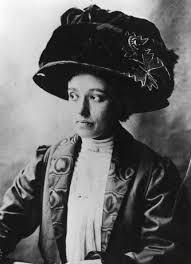 “Throws his feet out when walking??” “Looks intently when in conversation?”” Who wrote this police report for Scotland Yard? Was it one rogue guy who had aspirations as a fiction writer? Whoever it was, he had quite the flair for description.
“Throws his feet out when walking??” “Looks intently when in conversation?”” Who wrote this police report for Scotland Yard? Was it one rogue guy who had aspirations as a fiction writer? Whoever it was, he had quite the flair for description.
The post You Can’t Make This Stuff Up appeared first on Sarah Albee.

